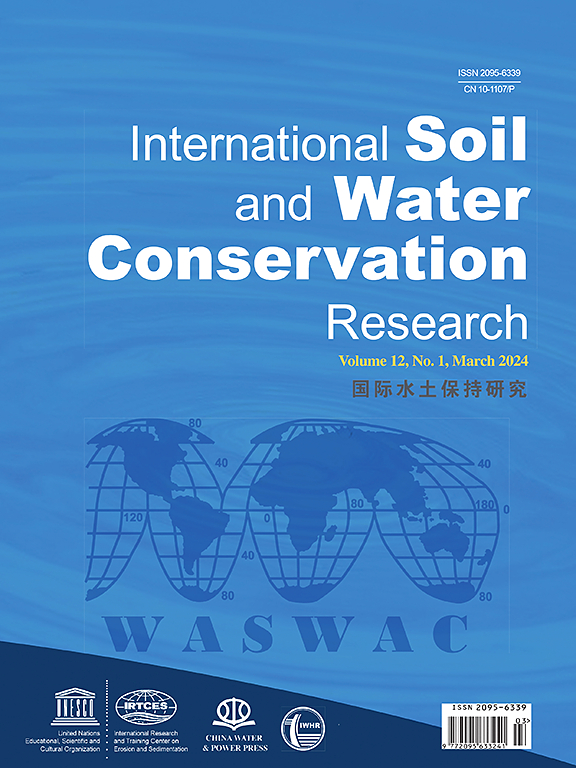Tracing soil erosion processes in Karst regions using rare earth elements: The role of bedrock outcrops and seasonal impacts
IF 7.3
1区 农林科学
Q1 ENVIRONMENTAL SCIENCES
International Soil and Water Conservation Research
Pub Date : 2025-04-05
DOI:10.1016/j.iswcr.2025.04.001
引用次数: 0
Abstract
In Karst regions, the impact of widespread bedrock outcrops on soil erosion processes is crucial and cannot be overlooked. These bedrock outcrops not only change the flow of surface runoff, but also have a significant influence on rainfall and sediment redistribution processes driven by runoff. This study aims to utilize simulation experiments and rare earth elements (REE) tracer technology to uncover the underlying effects of exposed bedrock outcrops on the soil erosion process, and the sediment transport patterns on slopes in karst regions during both dry and rainy seasons. The results demonstrate that the REE tracer technique holds considerable practical value for studying soil erosion processes on karst bedrock outcrop slopes. Seasonal variations in soil erosion rates are evident, with distinct differences between dry and rainy seasons due to rainfall flushing effects. Sediment migration on slopes shows both upward and downward movement, with predominant downward migration and deposition. Bedrock outcrops play a significant role in soil redistribution on karst slopes, hindering sediment transport and causing abrupt changes in rare earth element concentrations nearby. Monitoring and predicting soil erosion risk during the rainy season remains crucial for erosion prevention in karst regions. The impact of bedrock outcrops on soil erosion processes and spatial distribution in karst landscapes should be carefully considered when designing control measures. These findings offer a solid scientific foundation for understanding slope soil erosion mechanisms in karst regions and developing effective control strategies.
利用稀土元素追踪喀斯特地区土壤侵蚀过程:基岩露头的作用和季节影响
在喀斯特地区,广泛的基岩露头对土壤侵蚀过程的影响至关重要,不容忽视。这些基岩露头不仅改变了地表径流的流向,而且对径流驱动的降雨和泥沙再分配过程也有重要影响。本研究旨在利用模拟实验和稀土示踪技术,揭示基岩露头裸露对喀斯特地区旱季和雨季土壤侵蚀过程的潜在影响,以及坡面输沙模式。结果表明,稀土示踪技术对研究岩溶基岩露头坡面土壤侵蚀过程具有重要的实用价值。土壤侵蚀率的季节变化很明显,由于降雨冲刷效应,旱季和雨季之间存在明显差异。沉积物在斜坡上的迁移表现为向上和向下的运动,以向下的迁移和沉积为主。基岩露头在喀斯特坡面土壤再分配中起着重要作用,阻碍了沉积物的搬运,并引起附近稀土元素浓度的突变。雨季土壤侵蚀风险监测与预测是喀斯特地区水土流失防治的重要内容。基岩露头对岩溶景观土壤侵蚀过程和空间分布的影响应在控制措施设计中加以考虑。这些研究结果为认识喀斯特地区坡面土壤侵蚀机理和制定有效的治理策略提供了坚实的科学依据。
本文章由计算机程序翻译,如有差异,请以英文原文为准。
求助全文
约1分钟内获得全文
求助全文
来源期刊

International Soil and Water Conservation Research
Agricultural and Biological Sciences-Agronomy and Crop Science
CiteScore
12.00
自引率
3.10%
发文量
171
审稿时长
49 days
期刊介绍:
The International Soil and Water Conservation Research (ISWCR), the official journal of World Association of Soil and Water Conservation (WASWAC) http://www.waswac.org, is a multidisciplinary journal of soil and water conservation research, practice, policy, and perspectives. It aims to disseminate new knowledge and promote the practice of soil and water conservation.
The scope of International Soil and Water Conservation Research includes research, strategies, and technologies for prediction, prevention, and protection of soil and water resources. It deals with identification, characterization, and modeling; dynamic monitoring and evaluation; assessment and management of conservation practice and creation and implementation of quality standards.
Examples of appropriate topical areas include (but are not limited to):
• Conservation models, tools, and technologies
• Conservation agricultural
• Soil health resources, indicators, assessment, and management
• Land degradation
• Sustainable development
• Soil erosion and its control
• Soil erosion processes
• Water resources assessment and management
• Watershed management
• Soil erosion models
• Literature review on topics related soil and water conservation research
 求助内容:
求助内容: 应助结果提醒方式:
应助结果提醒方式:


